Will AI replace VFX Artists?
Introduction
The visual effects (VFX) industry has seen tremendous growth and innovation in recent years, largely driven by advancements in (AI) artificial intelligence and machine learning (ML). As AI capabilities continue to expand, there is much speculation about how this will impact VFX artists and their role in the creation process. In this article, we’ll examine the responsibilities of a VFX artist, review how AI is currently being used in VFX production, analyze the potential for AI to replace artists completely, and provide a balanced perspective on the future relationship between human VFX artists and AI.
What Does a VFX Artist Do?
VFX artists play a critical role in creating stunning visual effects for films, commercials, television shows, and other types of productions. Their primary responsibility is to help integrate digital, computer-generated imagery (CGI) into live-action footage to achieve visual effects that would otherwise be extremely difficult, dangerous, or impossible to capture on a physical set.
Some of the key tasks VFX artists perform include:
- Pre-visualization — Creating basic visual mockups and layouts during pre-production to represent planned VFX shots. This helps directors pre-visualize scenes.
- Matchmoving — Tracking specific points and elements in a live-action plate to then insert CGI elements that integrate seamlessly into the shot.
- Rotoscoping — Tracing and isolating specific elements frame-by-frame to separate them from the background for manipulation.
- Matte painting — Painting over or extending backgrounds to create realistic environments and backdrops.
- Lighting — Adding computer-generated lighting to create realistic interactions between CGI and live-action elements.
- Simulations — Creating realistic simulations of dynamic elements like cloth, liquid, smoke, fire, hair, etc.
- Compositing — Seamlessly blending together all the visual elements including CGI, live-action footage, matte paintings, etc.
VFX artists require a diverse skill set spanning both technical and creative areas. On the technical side, they need proficiency in specialized VFX software programs and a strong understanding of concepts like 3D product modeling, texturing, animation, and lighting. Equally important are creative skills like problem-solving, spatial awareness, composition, color theory, and attention to detail. The ability to cooperate and share effectively is also key.
Current Uses of AI in VFX
Artificial intelligence is already being utilized in the VFX industry in a variety of ways:
Pre-visualization
Complex VFX-heavy scenes are pre-visualized using AI algorithms to quickly generate low resolution CGI backgrounds, characters, effects simulations and camera motion. This allows directors and artists to rapidly iterate and experiment with different creative options.
Motion capturing
AI assisted motion capturing analyzes references of movement like dance or martial arts, and uses that to generate realistic motion curves for CGI characters and assets. This saves significant manual animation time.
Rotoscoping and masking
Powerful roto and masking tools leverage machine learning for frame-by-frame object segmentation. This auto-generation of mattes accelerates the usually tedious and time-consuming process.
Matchmoving
AI matchmoving tools can auto-generate point clouds from live action plates by identifying and matching common points across multiple frames. This provides a base for inserting and tracking CGI elements.
Lighting
Procedural AI lighting systems can accurately simulate realistic lighting interactions and atmospherics in fully CGI shots, taking into account elements like bounce lighting, transmission, global illumination, etc.
While still early, these applications clearly demonstrate how AI is making aspects of VFX production more automated, efficient, and higher quality. But could AI ever fully replace human VFX artists?
Can AI Completely Replace Artists?
Despite the impressive advancements, current AI still has significant limitations which likely prevent the complete replacement of VFX artists any time soon:
- Lack of common sense — AI lacks the logical reasoning and real-world knowledge that artists leverage for creative choices and problem-solving.
- Inability to make creative leaps — Algorithms cannot make the innovative conceptual leaps and non-linear connections that human creativity can.
- Difficulty handling ambiguity — AI struggles with loosely defined, subjective creative tasks compared to technical execution.
- No artistry and emotion — Pure AI lacks human artistic sensibilities, emotions, and subtleties that great VFX requires.
So while AI will continue to complement and enhance many technical aspects of VFX production, human oversight, artistry and creativity will remain essential. A more hybrid human-AI approach is likely in the near future.
Perspectives on the Future VFX Artist’s Role
Given AI’s rapid development, how should VFX artists respond to maintain their value? Here are some perspectives on successfully adapting to integrate emerging technologies:
- AI as a tool to assist artists — The core human skills of creativity, problem-solving and collaboration must evolve to view AI as a powerful toolset rather than a replacement.
- Develop alongside the tech — Artists should proactively learn new AI-enabled workflows so they can maximize its benefits rather than be displaced by it.
- Focus on higher value tasks — Automating lower complexity tasks via AI leaves more time to focus on high-level creative challenges only solvable by humans.
- Leverage hybrid thinking — Combining the complementary strengths of data-driven AI and emotion-driven human intelligence will drive innovation.
By proactively shaping their role in an AI assisted future rather than resisting change, VFX artists can continue delivering extraordinary visual experiences that touch the human spirit.
Conclusion
While AI is revolutionizing many technical facets of visual effects production, the uniquely human qualities of creativity, artistry, problem-solving and collaboration ensure VFX artists remain irreplaceable. Rather than replacing artists, AI should be viewed as a powerful tool to enhance productivity and quality. The most success will come from a hybrid approach combining the strengths of data-driven AI and emotion-driven human intelligence. By embracing AI as a partner rather than a threat, VFX artists can continue thriving and delivering extraordinary visuals that capture our imaginations. The future remains bright for this blend of art and science.
